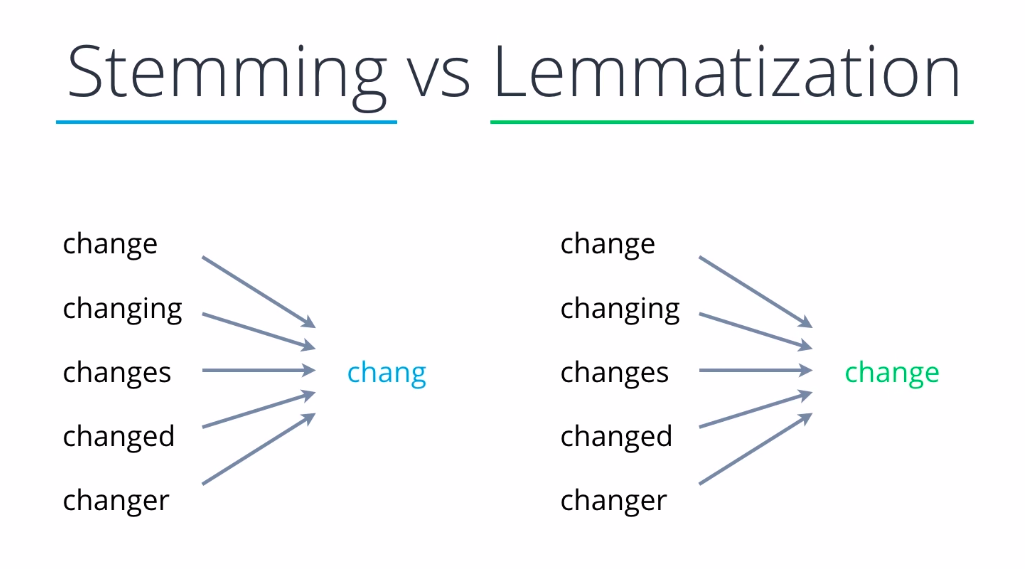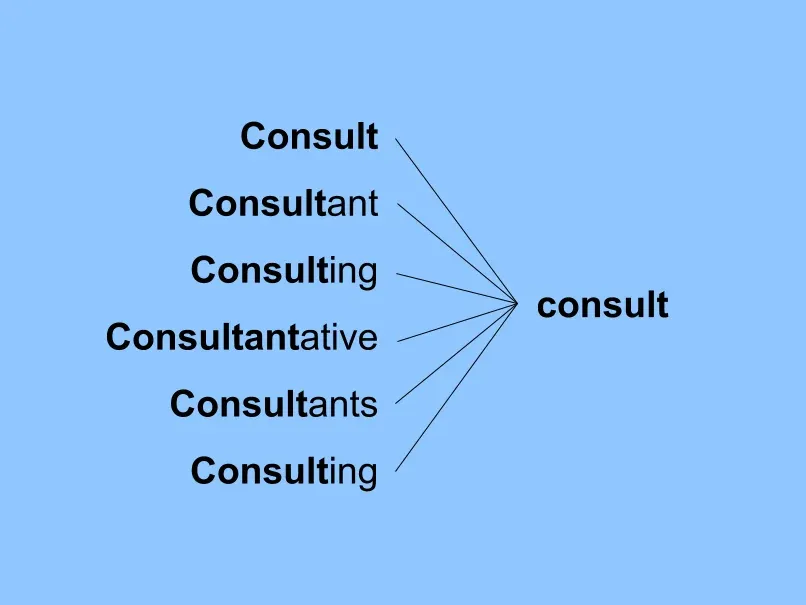Introduction
Stemming is a technique used in Natural Language Processing (NLP) that involves reducing words to their base or root form, called stems.
It plays a vital role in various NLP tasks, such as text analysis, information retrieval, and sentiment analysis.
Stemming in NLP: An Overview
Stemming, in the realm of Natural Language Processing (NLP), is quite like getting to the root of a plant but language-wise.
It's a technique used for trimming down a word to its root form, known as the 'stem'. The purpose of this linguistic "pruning" is to bring varying forms of a word down to their base core.
How Does Stemming Work?
Let's take an example. Consider the words "jumps", "jumping", and "jumped".
Notice any similarity?
Right - they all originate from the root word - "jump". Stemming helps us strip each of these words down to their 'stem' - "jump".
The magic here is that it can simplify analysis or processing by reducing words to their common base.
However, Stemming isn't always perfect. It can sometimes be too aggressive, chopping off parts of words leaving stems that are not grammatically correct.
For instance, "argue", "arguing", "argued" might be reduced to the stem "argu".
The Role of Stemming in NLP
By bringing words with similar meanings to their root form, stemming plays a crucial role in NLP.

Whether it's enhancing search algorithms, upscaling information retrieval, or facilitating sentiment analysis, stemming steps in to make language processing more efficient and intelligent.
Why are Stemming and Lemmatization Different?
In this section, we'll explore the differences between stemming and lemmatization, two crucial techniques used in natural language processing (NLP).
Basics of Stemming and Lemmatization
Let's start with the basics. Stemming and lemmatization are both ways to reduce words to their root form.

It's like having a family name that binds multiple individuals together. If the family name is 'run', then 'running', 'runner', 'runs' are all part of the family!
Approach to Root Form
Stemming is the rough and ready mechanic—it essentially chops off endings of words in the hopes of getting to the root, like snipping the branches off a tree.
It's fast but can be imprecise. On the other hand, lemmatization is the methodical botanist—it considers the context and does a deeper analysis, going back to the morphological ('shape-related') roots of the word, like tracing the tree right back to the seed.
Handling of Words
Stemming might not always return an actual word. For instance, 'running' could be stemmed to 'runn', which is not a meaningful word in English.
But lemmatization ensures the root word is a real word, like 'run', taking the grammatical structure into consideration. It's like trimming a bonsai tree, where understanding the bigger shape is crucial.
Speed and Accuracy
While stemming is quicker because it simply chops words, lemmatization requires more analysis and therefore, more time.
However the accuracy you gain with lemmatization can substantially improve an NLP model’s performance. So it's a bit of a tortoise vs hare situation - speedy stemming versus steady lemmatization.
Usage Scenarios
The right choice between stemming and lemmatization depends on the task. If speed is crucial and precision isn't important, like in a broad keyword search, stemming would work well.
However, for tasks requiring understanding of language and context like in a chatbot, lemmatization would be ideal.
Through these differences in approaches, handling of words, speed, accuracy, and usage scenarios, we can see how stemming and lemmatization are distinctly different, each with their unique advantages and disadvantages.
What are the Errors that Could Occur in Stemming?

In this section, we'll delve into the potential errors that can occur during the stemming process, a crucial step in text preprocessing in natural language processing.
Over-Stemming
Over-stemming happens when words that should be stemmed into different root forms are incorrectly stemmed to the same root.
This can lead to a significant loss of meaning and impact the accuracy of text analytics.
Under-Stemming
Under-stemming is the opposite of over-stemming, where words that should be reduced to the same root form are not.
This can introduce unnecessary complexity into the feature set and hinder the effectiveness of text analytics algorithms.
Stemming versus Lemmatization Errors
Sometimes, stemming can create non-existent words, whereas lemmatization guarantees the output is an actual word.
This can be a source of error, especially when the stemmed word cannot be accurately mapped back to its original form.
Impact on Sentiment Analysis
For sentiment analysis tasks, errors in stemming can lead to incorrect interpretation of sentiments.
This is especially true for distinguishing between different forms of a word that carry different emotional contexts.
Contextual Errors
Stemming can fail to account for the context, which can lead to errors.
Ignoring context can lead to words that have different meanings being reduced to the same stem, which might not reflect the same semantics
Which are some of the popular stemming algorithms?
In this section, we'll introduce you to some of the popular stemming algorithms frequently used in the domain of Natural Language Processing (NLP).
Porter Stemmer

The Porter Stemmer is a widely used stemming algorithm that applies a set of heuristics and a series of step-by-step rules to remove common word endings from English words.
Lovins Stemmer
The Lovins Stemmer has the distinction of being the earliest stemming algorithm.
It trims the longest possible suffix from a word while leaving a valid root, and is known for its simplicity and speed.
Dawson Stemmer
The Dawson Stemmer is a considerably more aggressive stemmer when compared to the Porter Stemmer.
It attempts to remove all affixes to reduce words to their root form, increasing the possibility of over-stemming.
Kraaij Pohlmann Stemmer
The Kraaij Pohlmann Stemmer is a Dutch-language stemmer that applies a set of rules to bring words back to their root form, similar to the approach used by the Porter Stemmer.
Snowball Stemmer

The Snowball Stemmer, also known as the Porter2 Stemmer, is an improvement over the original Porter Stemmer, offering a more moderate approach.
It supports stemming in several languages, making it a versatile choice for multilingual NLP tasks.
Advantages of Stemming
In this section, we will explore the benefits and impact of this technique in text mining and information retrieval.
Improved Text Analysis

Stemming allows for more effective text analysis by reducing different forms of words to their base form.
This simplification helps to uncover patterns and relationships within textual data.
Reduction of Dimensionality
By converting words to their stems, stemming reduces the dimensionality of text data.
This facilitates computational processing and improves efficiency in NLP applications.
Efficient Information Retrieval

Stemming improves information retrieval in search engines and document classification systems.
It enables more accurate matching of search queries with relevant documents by matching stems instead of exact word forms.
Use Cases of Stemming in NLP
Now let us find out some common use cases of stemming in NLP.
Document Classification
Stemming plays a crucial role in document classification tasks, where it helps in reducing the size of the feature space and mapping semantically similar documents to the same category.
Sentiment Analysis

In sentiment analysis, stemming allows for more accurate sentiment classification by eliminating variations in word forms.
It helps in identifying positive or negative sentiments associated with user opinions.
Information Retrieval
Stemming is widely used in information retrieval systems to improve search relevance.
By matching stems instead of exact word forms, stemming enhances the retrieval of relevant documents based on user queries.
Best Practices in Stemming

In this section, we will highlight the best practices that need to be used in stemming.
Proper Use of Stemming Algorithms
It is essential to select the appropriate stemming algorithm based on language and specific requirements.
Understanding the strengths and weaknesses of different algorithms helps in achieving better results.
Post-processing Stemmed Words
In some cases, additional post-processing of stemmed words may be required.
This could include handling specific exceptions or correcting stem variations to ensure optimal analysis.
Evaluating the Impact of Stemming
When applying stemming, it is important to assess its impact on the specific NLP task.
Considering the quality of the stemmed results and evaluating the overall performance can help gauge the benefits and limitations of stemming.
Frequently Asked Questions (FAQs)
What is Stemming in NLP?
Stemming in NLP refers to reducing words to their root form by removing affixes like prefixes and suffixes. It helps in text analysis by grouping similar words together.
What are some popular stemming algorithms?
Common stemming algorithms include the Porter Stemmer, Snowball Stemmer (Porter2), and Lancaster Stemmer. These algorithms apply linguistic rules to strip affixes from words.
How does stemming improve text analysis?
Stemming simplifies words to their base form, facilitating pattern recognition and relationship identification in textual data. It reduces redundancy and improves the efficiency of information retrieval.
Can stemming result in a loss of meaning?
Sometimes, stemming can lead to a loss of meaning as it removes affixes. The resulting stems may not capture the exact context or semantic nuances present in the original words.
When should I use stemming in NLP?
Stemming is useful in tasks like document classification, sentiment analysis, and information retrieval. It reduces dimensionality, enhances search relevance, and simplifies text analysis for these applications.

